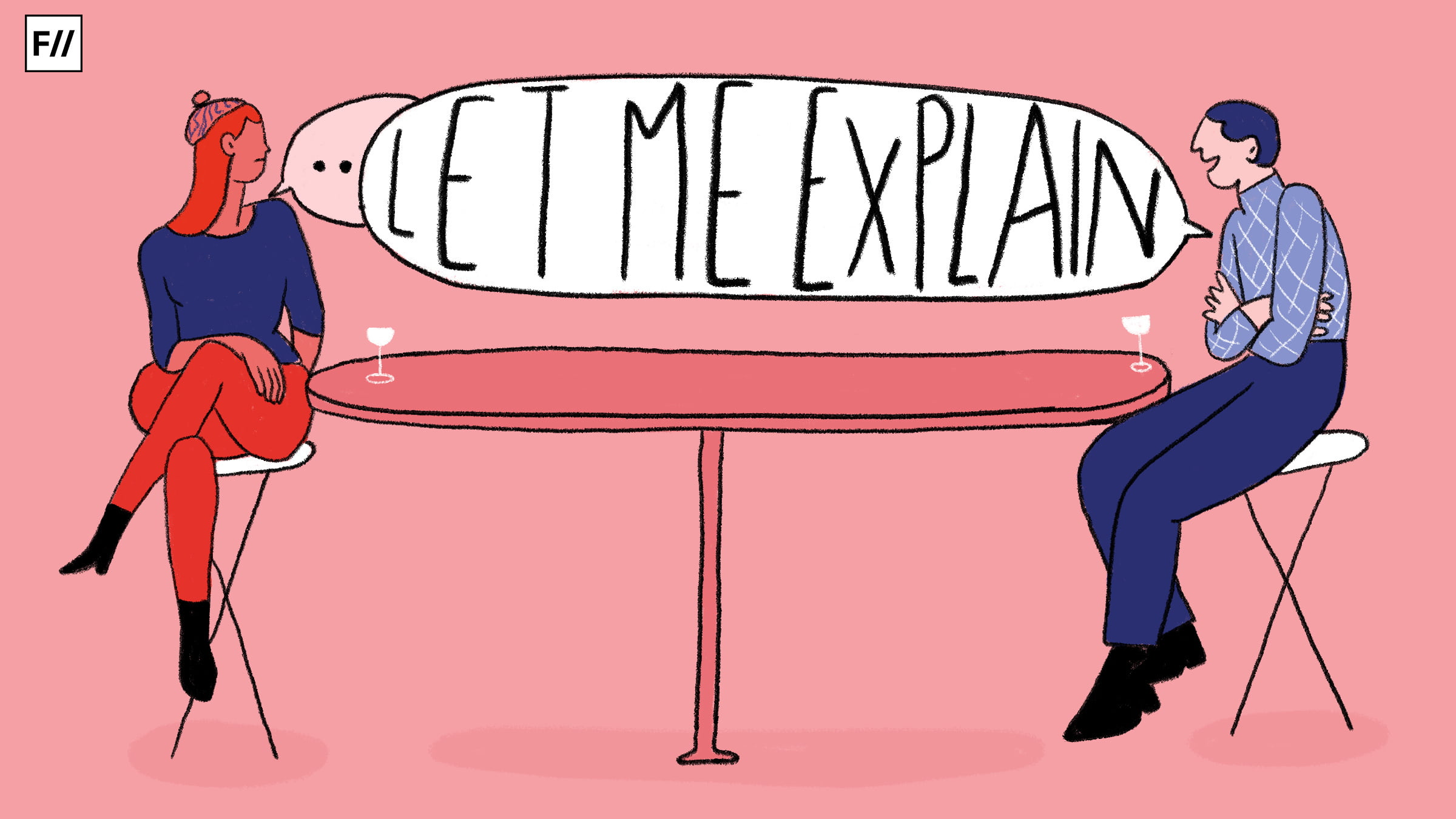The power structures that prevail in a patriarchal society have always privileged a man’s voice over that of women or transgender persons. This trend makes itself known through assigned gender roles and the normative hierarchy of opinions that place men at the top. In classrooms, this often takes the form of mansplaining.
According to Merriam Webster, mansplaining “is what occurs when a man talks condescendingly to someone (especially a woman) about something he has incomplete knowledge of, with the mistaken assumption that he knows more about it than the person he’s talking to does.” The fuel to this ‘mistaken assumption’ comes from society’s approval of male superiority as its default setting.
In the earlier days, this ‘intellectual superiority’ automatically attributed to men, could be said as derived from higher educational experiences, which women were systematically denied. However, with better access to education for all genders, it is ironic that the society still implicitly clings to such a false notion of intellect – especially in classrooms, where peers are supposed to have a similar level of educational qualifications.
Author Rebecca Solnit, who wrote an anecdotal and research-based essay in 2008 titled, “Men Explain Things to Me” is credited for coining the term ‘mansplaining‘. Solnit has stated that she wanted the term to be a systematic approach to convey a woman’s experience with casual sexism in a way that is more powerful than terms like ‘patronising.’ Her work emphasises the oppressive impact of silencing individuals, particularly women, through the abuse of systemic gender privilege.
According to a 2013 report by Oregon State University, boys take up nine times more linguistic space in the average high school classroom than girls. While boys are more likely to dominate talks and answer without the fear of being wrong, girls are more likely to speak only when they are confident in their response. Girls who are socially and systemically taught that being quiet is more valuable than being expressive, are expected to talk assuredly and make no mistakes in educational places from a young age, without considering the larger structural impediments. Such constant undermining of opinion has negative impacts on the speech patterns of women as well. Studies show that women are more likely to use tentative language
A similar phenomenon that joins this trend is the presence of ‘hepeating’. The term was made popular by U.S professor of astronomy and physics, Nicole Gugliucci, through a tweet in 2017. In the tweet, she explains, “My friends coined a word: hepeated. When a woman suggests an idea and it’s ignored, but then a guy says [the] same thing and everyone loves it.” The Guardian quotes it as another addition to the expanding glossary of sexist behavior towards women by men, like manterruption, manologue, and bropropriation.
Unsurprisingly, men are not amused by the concept. Historian Jeremy Black stated that the term was “an ugly new made-up word that’s foolish and devoid of meaning” and that it “should play no role in educational advice.”
Also read: Mansplaining: Men And Their Unsolicited Explaining Every Time I Travel
Implications for women and their voices
Women all across the world agree to the presence of mansplaining and say that it has reduced their confidence, signaling to them that their ideas were not welcome. When it starts in the classroom itself, it becomes all the more difficult for women to operationalise their agency later on in their life. Classroom discussions and debates privilege men’s loud voices and assertive tonality, whereas often shun a woman’s passionate argument as ‘emotional‘.
This tendency starts earlier on in households where women are systemically appreciated for their silence and for not being opinionated. Rani Padmini, a Malayalam movie made in 2015, had a titular character Rani, a woman running away from her husband’s home. In an attempt to showcase the restrictions society puts on women, the movie traces the journey of Rani who fits the ‘good girl’ stereotype perfectly, until she decides to assert herself.
In one of the scenes, she remarks, “Do not be happy if someone calls you an ‘adakkavum othukkavum Ulla kutti’ (a disciplined, well-mannered girl). It is a trap that forces you to fit into docile servitude for the rest of your life.”
Being quiet and ‘lady-like’ are often gilded cages that reinforce the idea that women are not supposed to voice their opinions in the public. The women who get to overcome such barriers and come to classrooms are then shut down by mansplainers who discredit their hard-fought voices.
According to a 2013 report by Oregon State University, boys take up nine times more linguistic space in the average high school classroom than girls. While boys are more likely to dominate talks and answer without the fear of being wrong, girls are more likely to speak only when they are confident in their response.
The momentum that Kamala Harris’, “Excuse me, I am speaking” during the Vice Presidential debates gathered is reflective of the frustration of millions of women who have been interrupted, regardless of the content of their speech. The inherent biases that men attain due to social conditioning which creates this sense of superiority need to be actively placed under scrutiny
Girls who are socially and systemically taught that being quiet is more valuable than being expressive, are expected to talk assuredly and make no mistakes in educational places from a young age, without considering the larger structural impediments. Such constant undermining of opinion has negative impacts on the speech patterns of women as well. Studies show that women are more likely to use tentative language.
Female students are frequently seen to be apologising and introducing their ideas with phrases such as, “This might be wrong, but” or, “I‘m not sure, but.” The term “feminine qualifiers” is sometimes used to describe these disclaimers. This tendency is reinforced by the juxtaposition of self-assured women as ‘arrogant‘.
While many women understand that their hesitant tone might undermine their arguments (or give space for others to mansplain), they are torn between seeking validation and expressing themselves assertively.
Addressing mansplaining: Towards solutions
Due to the prevalence of these mansplaining tendencies in classrooms, teachers must ensure they do not let it happen in classrooms. The trend is visible even in lower level classes as shown by educators Myra and David Sadker in their 1994 study which reported that boys were given more time to talk than girls in elementary classrooms.

The first step in making sure that classrooms remain inclusive of all voices is to teach or introduce the concept of mansplaining. This theoretical foundation can be converted to practical application by acknowledging mansplaining when it happens in class. Women should also be encouraged to practice responses to such situations.
The momentum that Kamala Harris’, “Excuse me, I am speaking” during the Vice Presidential debates gathered is reflective of the frustration of millions of women who have been interrupted, regardless of the content of their speech. The inherent biases that men attain due to social conditioning which creates this sense of superiority need to be actively placed under scrutiny.
Teachers should be aware of their prejudices against students of all genders and intervene when male students make condescending remarks or begin to “mansplain” female pupils. Teachers should also inform girls, as well as gender non-conforming or non-binary pupils, that their comments are important and don’t need to be justified any more than their male counterparts.
Only when there is an equality of voices in classrooms, can we teach the future one of the most important lessons that education should strive to instill – respect for others.
Also read: How Nathicharami Tries To Explain Female Sexuality Through Mansplaining
About the author(s)
Stephy is a masters student in Jamia. Her interests revolve around issues of conflict and peace, gender and mental health. She hopes to shed her inherent biases daily and become a better ally each day





Both male teachers and female teachers are much more polite to female students compared to male students in speech. Female students also get away with simple warnings while male students are punished for the same wrong act. Teachers also take complaints of female students seriously without even bothering to find out if she is lying or telling the truth. Female students are treated much better in every way.